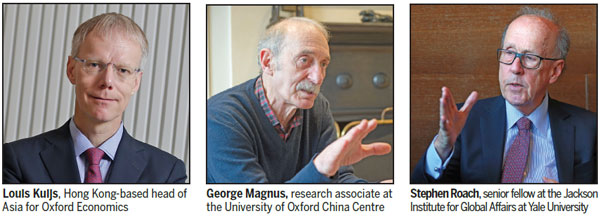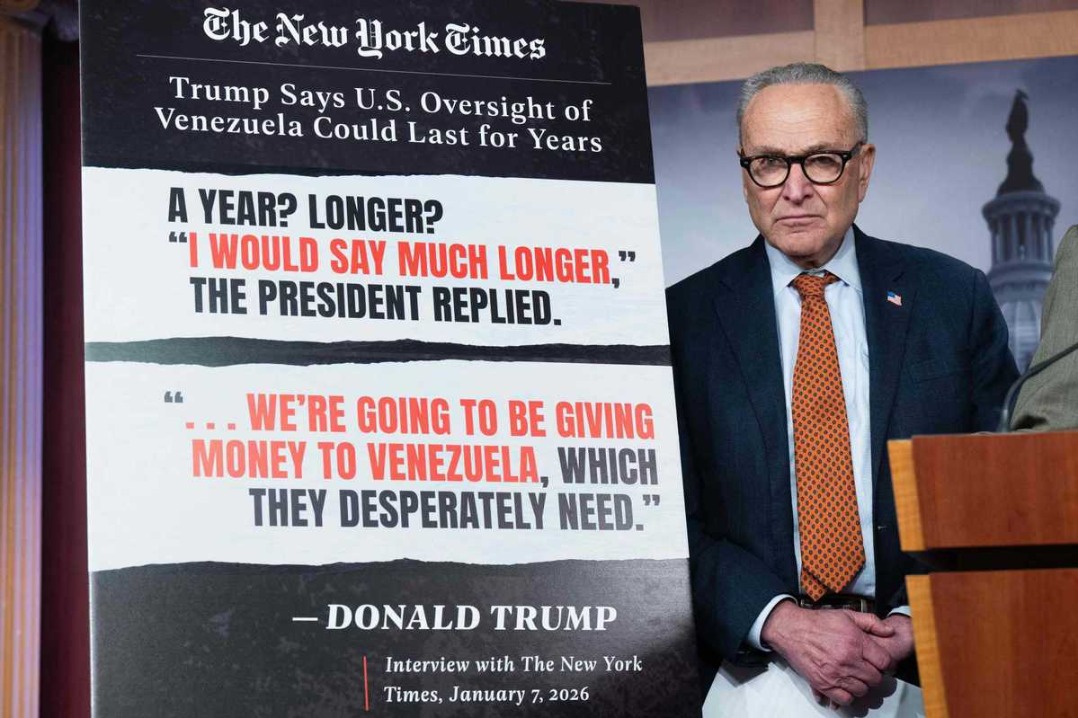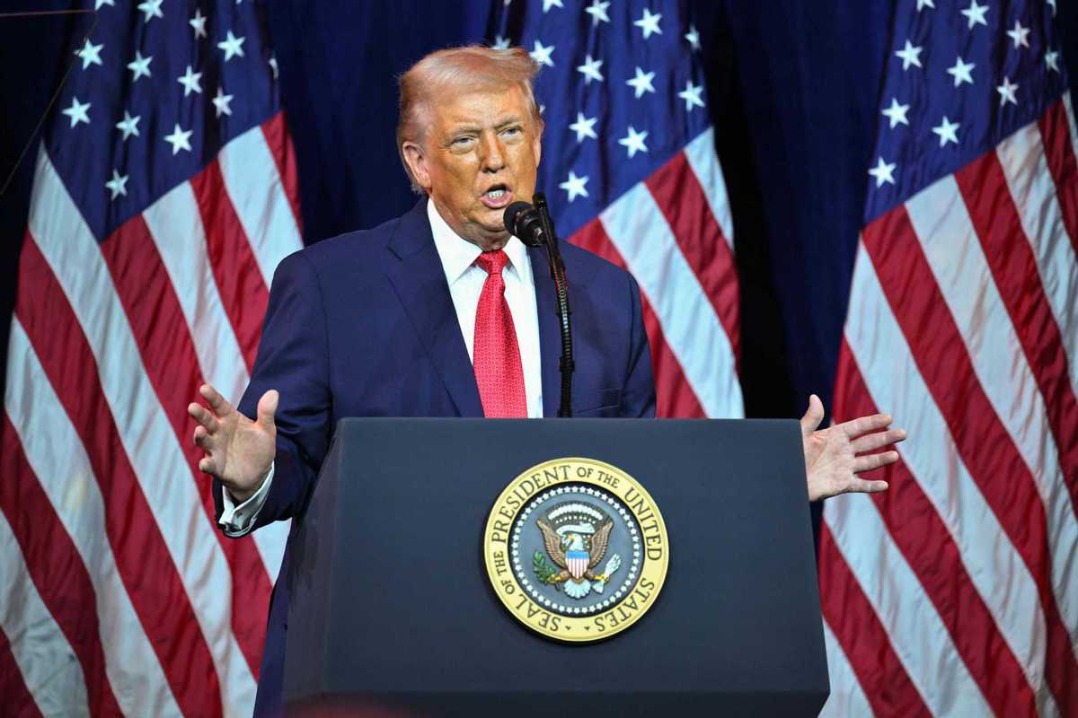On course

As reform continues, China is well on its way to targets for 2020 on GDP, per capita income and erasing poverty
China is set to continue its strong growth this year and is on course to become a "moderately well-off society" by 2020, according to experts.
The economy is expect-ed to grow by 6.4 percent over the year, according to a World Bank forecast on Dec 19.

The Chinese government's target last year of around 6.5 percent, "or higher, if possible", already looks set to be comfortably achieved, with 6.8 percent recorded in the third quarter after two successive quarters of 6.9 per-cent. The full-year data will be available later this month.
The global economy is also set to deliver one of its best performances since the immediate aftermath of the global financial crisis, with the IMF forecasting GDP growth of 3.7 percent for the year ahead.
There also appears to be a less uncertain outlook compared with the beginning of last year, when concerns arose about then newly elected US President Donald Trump following a protectionist agenda and there were worries about a far-right breakthrough in the French presidential election as well as the repercussions of Brexit.
The main worry this year will be how the global economy will react to a tightening of monetary policy in the United States, with the Federal Reserve expected to raise interest rates three or even four times during the year.
For China, hitting the 2020 target of doubling 2010 GDP and per capita income is an important one, since it will come in time for the 100th anniversary of the founding of the Communist Party of China in 2021.
It also would mean that the world's second-largest economy had escaped the so-called middle-income trap that has befallen many developing countries, and had become a high-income country.
This will be the first year when economic policy will be informed by Xi Jinping Thought on Socialism with Chinese Characteristics for a New Era. This places emphasis on the Party's leadership in economic management as well as the market's role in resource distribution and economic development that benefits the population as a whole, in addition to supply-side structural reform.
The policy goals were set out at the Central Economic Work Conference held in December in Beijing.

In his New Year address, President Xi reaffirmed his solemn commitment to lift all of the country's rural impoverished people out of poverty under current standards by 2020.
"This will be the first time in thousands of years of Chinese history that extreme poverty has been eliminated," Xi said.
China will also take the opportunity on the this year's 40th anniversary of reform and opening-up to carry them through to the end, Xi said, pledging efforts to "surmount all obstacles to carry the reform further to its ultimate triumph".
"Reform and opening-up has been the only path to the development and progress of contemporary China, and the only path to the realization of the Chinese dream," he said.
The government is looking to achieve higher-quality and more sustainable growth as well as greater equality in terms of sharing economic benefits, and to manage financial risk both by reining in debt and preventing asset bubbles, particularly in the property sector.
Louis Kuijs, Hong Kong-based head of Asia for Oxford Economics, expects the growth target to be set at around 6.5 percent in March, but he believes there would be benefits to setting it lower.
"If the target for growth were 6.3, or even 6.2 percent, it would take off some of the pressure, which in my view would be good."
He believes that policy this year will be informed by Xi's report to the 19th CPC National Congress in October and the new era Xi has espoused.
"We are entering a new era and people's expectations are rising, so there will be a focus on doing better in providing good education and better healthcare. For the economy to afford such fiscal outlay, there will also have to be an emphasis on innovation, such as the Made in China 2025 strategy and the upgrading of the economy," he says.
"In terms of growth, quality is now going to be more important than the quantity of the past, and also a recognition that the economic benefits need to be more equally spread across society."
Stephen Roach, senior fellow at the Jackson Institute for Global Affairs at Yale University, expects the Chinese government to set a target of between 6 and 6.5 percent and be on course for its central aim of doubling 2010 GDP per capita by 2020.
However, he believes the main challenge remains the reform of State-owned enterprises.
"It is the one area of reform in China that I am most concerned with. I don't believe the mixed ownership approach (China is piloting private-sector investment in some SOEs) is the right solution. This is about financial engineering when the real problem is essentially operational efficiency."
For Roach, the author of Unbalanced: The Codependency of America and China, the main global risk this year is the US economy, with the potential of equity markets responding badly to the expected interest rate increases by the Federal Reserve.
"The end of easy money could lead to an overreaction in the equity markets, especially in the US, where price-earnings ratios are higher than at any point other than 1929 (before the Wall Street Crash) or 2000 (at the height of the dot.com bubble)," he says.
"This correction could be 10 to 15 percent, but it could be of crisis proportions if there were any shocks such as the risk of a military confrontation in North Korea or some kind of US-China trade war."
Donna Kwok, senior China economist at investment bank UBS in Hong Kong, believes the target for growth will be set at around 6.5 percent.
"They have set themselves an explicit target of at least 6.3 percent for the next three years (to achieve the overall 2020 target) and I expect them to continue with this range. It serves a purpose in that it anchors expectations both within China and outside."
She says monetary conditions within China are currently quite "tight". The People's Bank of China raised its central rate by 5 basis points in December within hours of the Fed raising its rate by a quarter of a percentage point.
"If we are going to see any new direction of policy this year, it will come in the second quarter, and you might find macro policy a little less hawkish than it is now," she says.
"The government has been pushing through reforms mainly to contain financial risk and it has been able to do so with growth also doing OK.
"It may take off some of that intensity during the year. I think with the leadership we have now, there would be no return to the traditional levers such as infrastructure investment to drive the economy should growth fall below expectations."
Zhu Ning, Oceanwide professor of finance at Tsinghua University and author of China's Guaranteed Bubble, believes stronger-than-expected growth last year was supported by the boom in the housing market in 2016, which saw prices soar in Shanghai, Beijing and other major cities by more than 20 percent.
"There was a wealth effect from this, and that is why I expect growth to gradually come down the stairs in 2018."
He expects the government to set a target of around 6.5 percent, but he believes there are still financial risks in the economy and the risk that asset bubbles may burst, particularly in the housing sector.
"The real risk is in the third- and fourth-tier cities rather than in the major ones. I would not be surprised if there is a 20 to 30 percent correction there. It is fair to say there is no real demand in many of these cities."
George Magnus, research associate at the University of Oxford China Centre, says 2017 was an unusual year when the global economy was "firing on all cylinders", with most regions doing well - and he expects some of that momentum to be carried forward into this year. He also expects China to target 6 to 6.5 percent growth.
"The upside surprise of last year was how diversified global growth was. The US seemed in particularly good shape, Japan was chugging away, Europe - apart from perhaps the UK - was having a purple patch, and China was a lot more stable than many thought would be the case only 18 months ago."
He is concerned, however, that the US in particular is now in its third-longest expansionary phase since the end of World War II, extending to 102 months since June 2009, according to the Cambridge, Massachusetts-based National Bureau of Economic Research.
If this continues until June this year, it will surpass the expansion between February 1961 and November 1970. The longest expansion since 1945 was between March 1991 and November 2001.
"The concern has to be that this expansion is becoming very long in the tooth, and although you cannot see any overt catalyst for a business slowdown, we are surely due for one to happen."
Michael Power, strategist for Investec Asset Management based in Cape Town, South Africa, expects China to be able to achieve an average of 6 percent growth up to 2030, putting it on course to be the world's largest economy.
"This is a distinct possibility. I expect it to be higher in the shorter term and lower in the longer term," he says.
He believes the strength of China's economy remains important for commodities on which many African economies still depend, and he expects them to continue their recovery in 2018.
"Providing there is no explicit negative financial event in 2018, most commodity prices will continue to edge up, but some will probably do better than others. Those metals associated with the renewable revolution such as lithium, cobalt, nickel and aluminum will continue their secular bull run until the supply side can catch up with their burgeoning demand. This will benefit Zambia and the Democratic Republic of Congo with their significant copper and cobalt production."
Power says that as China enters a new era, it is seen as a development role model by a number of African countries.
"Eastern Africa and, in particular, Ethiopia, is following China's example of manufacture-for-export to a far greater degree than the rest of the African continent. It helps that eastern Africa is Africa's best-positioned geographic region, looking across the Indian Ocean at a fast-growing Asia," he says.
"Much of the rest of Africa has not moved beyond the model of commodity, services and consumption-led growth."
Douglas McWilliams, deputy chairman of the Centre for Economics and Business Research in London, believes China grew faster in 2017 than the official figures suggest. He believes GDP has risen by around 10 percent and that the target may be around 7 percent for 2018.
"The rate of growth of imports has been 20 percent, and if you halve that, you normally get the GDP growth rate. I believe the official statistics are always accurate over the longer term, but there is a tendency to underreport in the good years, of which 2017 was one."
In his economic research consultancy's World Economic League Table published on Dec 26, China is predicted to overtake the United States as the world's largest economy by 2030. It also points to India overtaking the UK and France to become the world's fourth-largest economy in 2018.
"Looking forward, India could be on course to becoming the world's largest economy toward the end of the century because of its growing population, although it will remain a long way behind in per capita income terms," he says.
In the league table, African countries also feature prominently with Nigeria, Africa's biggest economy, ranked 31st in 2018 and South Africa 33rd. By 2032, Egypt is expected to be Africa's largest economy, ranking 26th in the world.
"All the African countries are climbing up the league table, although I am less optimistic about South Africa and Nigeria because of structural weaknesses," McWilliams says.
Debt risk in China is likely to remain a significant issue this year. An International Monetary Fund report published in December, which praised President Xi's commitment to tackling the issue, pointed out that credit growth had outpaced GDP growth and was now 25 percent above its long-term trend.
It also highlighted that corporate debt was now 165 percent of GDP and household debt had grown markedly, largely as a result of speculation in the housing market.
Roach at Yale insists, however, that this is unlikely to result in a debt crisis.
"The government can still handle this. China has an extraordinary savings rate. They have a very high level of foreign exchange reserves and they are not exposed to international short-term hot money supporting the economy, which was the problem of the Asian financial crisis of the late 1990s. They have a cushion and time to address this."
Kwok at UBS believes the risk of a debt crisis receded over the past year.
"I would say there is less concern than this time last year. Although it is still a serious issue, there have been some structural improvements in China's overall debt picture. So although debt to GDP is set to continue to rise over the next two to three years, it will be at a slower pace than before."
This year is important for China in that it is the 40th anniversary of the launch of reform and opening-up by Deng Xiaoping in 1978.
China's opening up to the outside world is seen by those close to China as one of the momentous events in world history, eventually delivering 700 million people out of poverty.
Magnus, who is set to publish a new book Red Flags this year which will argue that reform and opening-up was one of China's greatest institutional reforms, says the initiative cannot be underestimated.
"Without question, China's rise over the past 40 years was down to reform and opening-up. It is a period in which productivity exploded as a consequence of the policies that were followed. We haven't really seen anything like that," he says.
"People who know about China are acutely aware of this, but I am not sure whether this is so generally understood in the West."
Kuijs at Oxford Economics also believes that reform and opening-up was momentous, but says it is the platform on which it is now moving on to a "new era" where the focus will not just be on economic growth.
"It was clear from the Party Congress there is now going to be much more focus on tackling inequality within society and dealing with environmental issues," he says.
"The leadership, however, also want to build on the previous legacy by further opening up the economy to the outside world and open up markets to foreign companies."
Roach at Yale says he is more optimistic about the outlook for China following the CPC's 19th National Congress, during which Xi laid out his goals for China up to the middle of the century.
"I drew a lot of comfort from Xi's commitment to deal with the key economic issues facing China. He has added an ideological dimension to this, when what went before was largely analytical. His focus on governance and implementation is absolutely vital if the goals that have been set are to be met."
andrewmoody@chinadaily.com.cn
Key messages from Central Economic Work Conference
1. Xi Jinping Thought on Socialist Economy with Chinese Characteristics for a New Era is put forward for the first time. Emphasis is on the Party's leadership in economic management.
2. High-quality development and more efficient economic growth will be pushed ahead.
3. Prudent and neutral monetary policy and proactive fiscal policy regulating local government debt are expected.
4. A crackdown will target illegal activities in the financial industry to forestall risks.
5. Policies will extend affordable housing for both buying and renting.
6. Measures will target poverty reduction in order to eliminate all extreme poverty by 2020.
7. Significant measures will reduce pollution.
8. Imports for balanced trade and new free trade zone pilot areas will be boosted to encourage foreign investment.



































